这篇文章主要介绍了java中类型自动转换机制的示例分析,具有一定借鉴价值,感兴趣的朋友可以参考下,希望大家阅读完这篇文章之后大有收获,下面让小编带着大家一起了解一下。
自动类型转换也叫隐式类型转换
表达式的数据类型自动提升
所有的byte型、short型和char的值将被提升到int型。
如果一个操作数是long型,计算结果就是long型;
如果一个操作数是float型,计算结果就是float型;
如果一个操作数是double型,计算结果就是double型。
int值可以赋值给long、float、double型变量,不能赋值给byte、short、char型变量
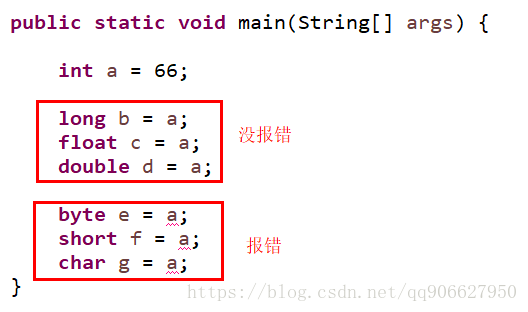
对于函数的传参也是一样
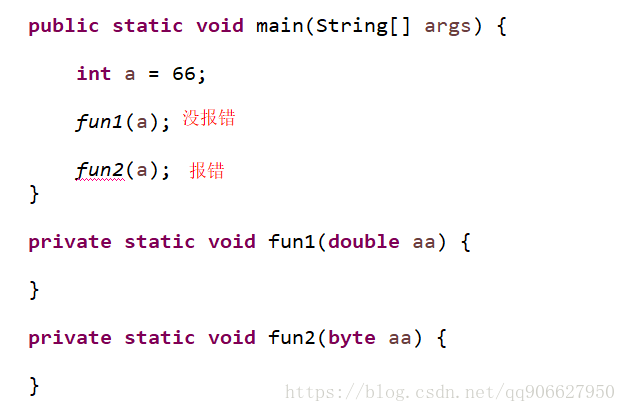
当然,在有函数重载的情况下,java编译器会自动选择最匹配的函数进行调用
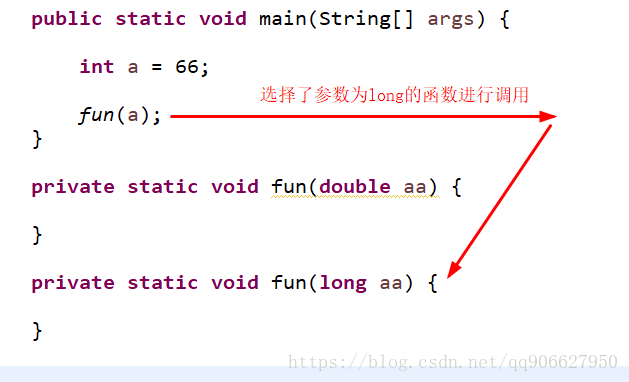
所有长度低于int的类型(byte、short、char)在运算之后结果将会被提升为int型
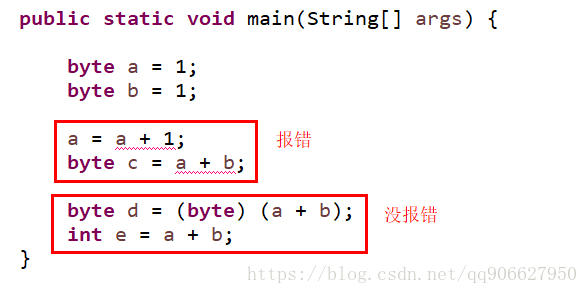
当然还有以下的这种情况,这种情况是因为我们在进行赋值运算的时候,java编译器可以明确知道运算的结果是否超过byte或short的取值范围,所以 byte a = 1 + 1; 并没有报错。而上面 byte c = a + b; 编译出错的原因是因为a和b均为一个变量,相加的结果是否会超过byte的取值范围编译器并不知道,所以编译器将结果提升为int型了。

小结一下:
当编译器明确知道整数的运算结果没有到达int的表示范围时,byte、short或char类型的运算结果不会被自动提升为int类型
当编译器明确知道或不清楚整数的运算结果是否到达int的表示范围时,编译器将会自动将运算的结果转换成int,即使原来是byte、short或char类型。
答: 赋值 | 运算时 ,两边数据类型不一致时就会发生类型转换
如下:
public class TypeTest {
public static void main(String[] args){
// 运算时发生的隐式类型转换,两整数相除得到的还是一个整数
byte a = 3;
byte b = 4;
int num = a + b;
System.out.println(num); // 7
// 赋值时发生的隐式类型转换
int ch = '0';
System.out.println(ch); // 48
// 运算时发生的强制类型转换
byte a1 = 12;
byte a2 = 12;
byte num1 = (byte)(a1 + a2);
System.out.println(num1); // 24
// 赋值时发生的强制类型转换
short b3 = 1234;
byte a3 = (byte) b3;
System.out.println(a3); // -46
}
}运行截图:

自动类型转换
强制类型转换
规则:从小到大 ,低字节向高字节自动提升
顺序:
byte(1字节) – > short(2字节)-- > int(4字节) – > long(8字节) --> float(4字节) – > double(8字节)
char (2字节)-- > int(4字节) – > long(8字节) --> float(4字节) – > double(8字节)
画图分析:
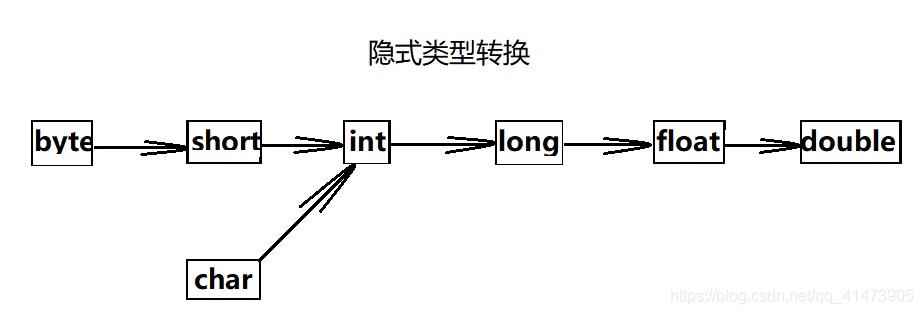
代码展示:
public class TypeDemo {
public static void main(String[] agrs){
// byte -- > short
byte b1 = 127;
short s1 = b1;
System.out.println(s1); // 127
// short -- > int
short s2 = 30000;
int i = s2;
System.out.println(i); // 30000
// int -- > long
int num = 2100000000;
long lg = num;
System.out.println(num); // 2100000000
// long -- > float
long lg1 = 200000000000000L;
float f1 = lg1;
System.out.println(f1);// 2.00000001E14
// float -- > double
float f2 = 3.14f;
double d1 = f2;
System.out.println(d1); // 3.140000104904175
// char -- > int
char ch = 'a';
int i1 = ch ;
System.out.println(i1); // 97
// char -- > long
char ch2 = 'b';
long lg2 = ch2;
System.out.println(lg2); // 98
// char -- > double
char ch3 = 'c';
double dou = ch3;
System.out.println(dou); // 99.0
// char -- > float
char ch4 = 'd';
float f3 = ch4;
System.out.println(f3); // 100.0
}
}运行截图:
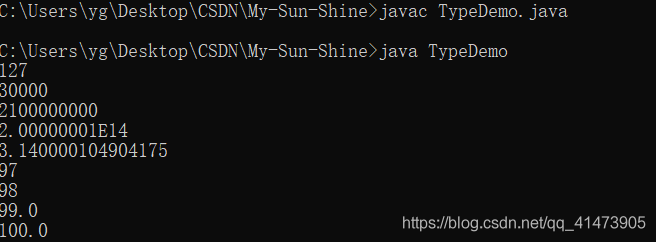
注意:
byte、short不能和char进行相互转换
代码展示:
public class TypeDemo2 {
public static void main(String[] agrs){
// byte -- > char
byte bt = 127;
char ch = bt;
System.out.println(ch);
// short -- > char
short sh = 12;
char ch2 = sh;
System.out.println(ch2);
}
}编译错误截图:

float虽然是4个字节,但是float比long表示的数据范围更大。说明数据范围的大小和字节的大小不一定相关
代码展示:
public class TypeDemo3 {
public static void main(String[] agrs){
long lg = 20000000000000L;
float f1 = lg;
System.out.println(f1); // 1.99999997E13
}
}运行截图:

boolean类型不能参与类型转换
代码展示:
public class TypeDemo4 {
public static void main(String[] agrs) {
boolean flag = 12;
int flag1 = flag;
System.out.println(flag1);
}
}编译错误截图:
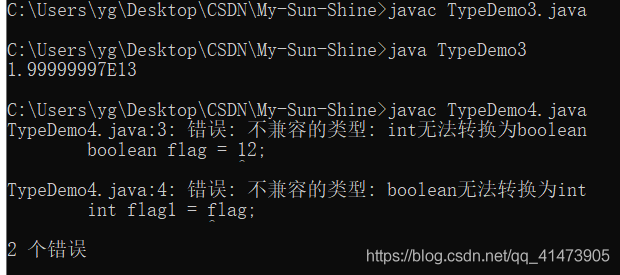
规则:从大到小,高字节向低字节手动强制转换
顺序:
double(8字节) – > float(4字节) – > long(8字节) – > int(4字节) – > short (2字节)-- > byte(1字节)
double(8字节) – > float(4字节) – > long(8字节) – > int(4字节) – > char(2字节)
画图分析:

(掌握)格式:目标数据类型 变量名 = (目标数据类型) 变量 | 常量;
代码展示:
public class TypeDemo5 {
public static void main(String[] agrs){
// float -- > long
// final float PI = 3.14f;
// long num = (long) PI; // 3
// float little = 3.14f;
// long num = (long)little; // 3
long num = (long)3.14f;
System.out.println(num);// 3
// double -- > float
// double dou = 3.14;
// float little1 = (float)dou; // 3.14
// float little1 = (float) 3.14d; // 3.14
final double dou = 3.14;
float little1 = (float)dou;
System.out.println(little1); // 3.14
// long -- > int
// long num1 = 2000000000000L;
// int num2 = (int)num1; // -1454759936
// int num2 = (int)2000000000000L; // -1454759936
final long num1 = 2000000000000L;
int num2 = (int)num1;
System.out.println(num2); // -1454759936
// int --> short
// int num3 = 12;
// short num4 = (short)num3; // 12
// short num4 = (short)40000; // -25536
final int num3 = 60;
short num4 = (short)num3;
System.out.println(num4); // 60
// short -- > byte
final short sh = 12345;
byte bt = (byte)sh;
System.out.println(bt); // 57
short sh2 = 78;
bt = (byte) sh2;
System.out.println(bt); // 78
}
}运行截图:

注意:
强制类型转换有数据丢失,一般不建议使用
代码展示:
public class TypeDemo6 {
public static void main(String[] agrs) {
short a = 1245;
byte b = (byte)a;
System.out.println(b);
}
}运行截图:

感谢你能够认真阅读完这篇文章,希望小编分享的“java中类型自动转换机制的示例分析”这篇文章对大家有帮助,同时也希望大家多多支持亿速云,关注亿速云行业资讯频道,更多相关知识等着你来学习!
亿速云「云服务器」,即开即用、新一代英特尔至强铂金CPU、三副本存储NVMe SSD云盘,价格低至29元/月。点击查看>>
免责声明:本站发布的内容(图片、视频和文字)以原创、转载和分享为主,文章观点不代表本网站立场,如果涉及侵权请联系站长邮箱:is@yisu.com进行举报,并提供相关证据,一经查实,将立刻删除涉嫌侵权内容。